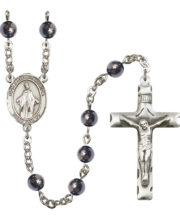Mary
Our Lady of Africa
What is the devotion to Our Lady of Africa
Our Lady of Africa, also known as Notre-Dame d’Afrique, is a Marian devotion that centers around a statue of the Virgin Mary located in the Basilica of Our Lady of Africa in Algiers, Algeria. The statue, which is made of marble and stands over six feet tall, depicts Mary holding the baby Jesus in her arms and standing on a crescent moon.
The devotion to Our Lady of Africa has a long history that is closely tied to the history of Christianity in Algeria. The statue was originally placed in a small chapel on the hill of Bouzaréah in 1872. The chapel was built by French colonial authorities as a way to honor Mary, the mother of Jesus, and to provide spiritual support for the large number of French soldiers and settlers living in the area. The chapel quickly became a popular pilgrimage site, and over time, the devotion to Our Lady of Africa spread to other parts of Algeria and to other countries in North Africa.
In 1878, French Archbishop Charles Lavigerie started the “White Fathers”, a missionary order that focused on evangelizing Africa. They built the present Basilica in 1901, in the same location as the previous chapel, and the devotion continued to grow. It was consecrated by Pope Pius XI on 21 December,1926. The basilica is one of the largest and most significant Catholic churches in North Africa, and it continues to be a major pilgrimage site for Catholics from all over the world.
The devotion to Our Lady of Africa is not only significant for Catholics in North Africa, but also for Catholics around the world. The statue of Mary is seen as a symbol of hope and of the unity of Christians from different cultures and backgrounds. In the Basilica, people from different ethnic and national groups gather to pray and to seek Mary’s intercession. The devotion to Our Lady of Africa is seen as a way to promote peace and understanding between different groups and to work for the common good of all people.
The feast day of Our Lady of Africa is celebrated on the Sunday closest to the feast of the Assumption (August 15th), which is celebrated as a major feast day in the Catholic Church. Pilgrims from all over Africa, Europe and other countries, come to Algiers to celebrate the feast day and to participate in the many religious ceremonies that take place in the Basilica.
The devotion to Our Lady of Africa also has a special meaning for the people of Algeria. The statue of Mary has come to symbolize the country’s history and its culture, as well as its hopes for the future. Many Algerians see the statue as a symbol of the nation’s resilience and its ability to overcome the challenges it has faced in the past.
Throughout its history, the devotion to Our Lady of Africa has played an important role in the spiritual and cultural life of North Africa. It has brought people together in prayer and has served as a source of hope and inspiration for many. Even today, the devotion to Our Lady of Africa continues to be a powerful force for unity and peace in a region that has seen much conflict and division.
In summary, the devotion to Our Lady of Africa centers around a statue of the Virgin Mary located in the Basilica of Our Lady of Africa in Algiers, Algeria. The devotion has a long history that is closely tied to the history of Christianity in Algeria. The statue is seen as a symbol of hope and of the unity of Christians from different cultures and backgrounds. The feast day is celebrated on the Sunday closest to the feast of the Assumption and the devotion plays an important role in the spiritual and cultural life of North Africa and continues to be a powerful force for unity and peace in the region.
The Feast of Our Lady of Africa
The Feast of Our Lady of Africa is celebrated on August 15th, the same day as the Feast of the Assumption of Mary. It is a feast day that is celebrated by the Catholic Church in the African continent, particularly in Algeria, Tunisia and Morocco.
The celebration of Our Lady of Africa can include the following:
Mass attendance: Many parishes will have a special Mass to commemorate the Feast of Our Lady of Africa.
Devotions and prayers: Many Catholics will choose to pray the rosary or recite other prayers dedicated to Our Lady of Africa.
Processions: Some parishes may organize a procession with a statue of Mary in honor of Our Lady of Africa.
Artistic and cultural activities: Some parishes may organize or participate in artistic or cultural events to honor Our Lady of Africa, such as singing religious songs, storytelling, dance, or theater performances.
Reflection and meditation: Many Catholics may choose to reflect on the teachings and messages associated with Our Lady of Africa, such as the importance of humility and devotion.
Charitable works: Some parishes may organize charitable works such as feeding the hungry, helping the poor or visiting the sick, as an act of devotion to Our Lady of Africa.
It is important to note that the celebration of the Feast of Our Lady of Africa may vary depending on the country or region, and it is not a universally celebrated feast day.


